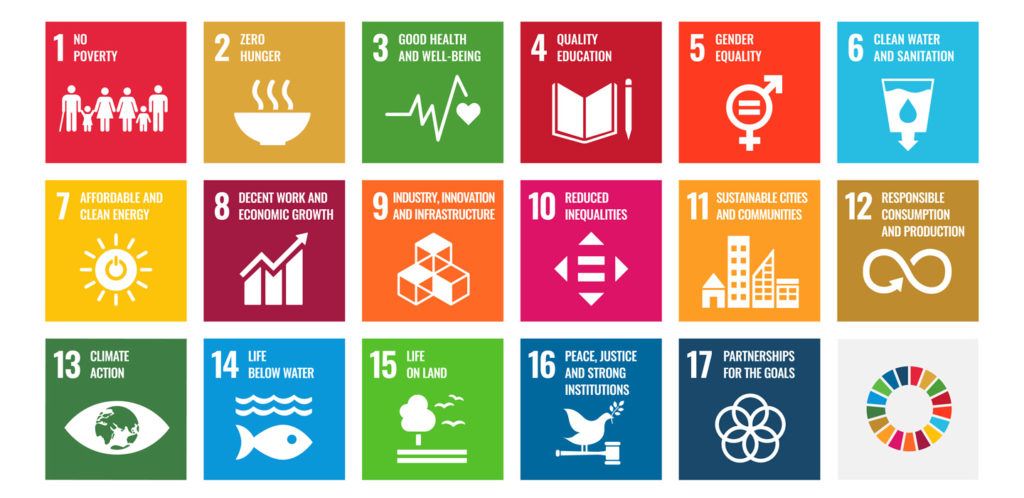De-mystifying Sustainability in a World That’s Increasingly Obsessed With It

By Rehan Aneksha | May 2024
“The greatest threat to our planet is the belief that someone else will save it” – Robert Swan
So, what is sustainability?
Sustainability– in the broadest sense– means the ability to maintain a pre-defined state. In the global context, this pre-defined state is one where life on earth can co-habit without unmanageable detriment.
It is important to recognise that sustainability is not about saving the planet itself – the planet will likely outlive the ongoing destruction and continue adapting. Sustainability is about protecting the living things that inhabit it. The priorities to sustain human life are best defined by the 17 UN SDGs (Sustainable Development Goals, A.K.A, The Global Goals):

The drivers of impact in each of the seventeen areas are systematically linked, where no single problem can be solved without considering another, in a concept you may be familiar with called ‘systems thinking.’ An easy example of this is how the expansion of farming drives land use change, which can, in turn, drive economic changes and migration. It is important to consider wider systemic impacts when trying to solve any one problem to ensure there is a net benefit to the entire system. This is why problems are often more complex than they seem at face value, especially when we attempt to solve them in silos.
Why is it an important problem?
Life on Earth
Sustainability aims to fulfill human wants and needs without affecting our species’ ability to do so in the future. This extends to the plants and animals in our ecosystems that we depend on, as well as the societies and economies we rely on to maintain the conditions for human life.
We have exceeded our impact budget on multiple fronts – some deeply irreversible (IPCC, 2022). We have caused the normal planetary heating cycle to exceed normal limits, causing runaway global average temperature rises and adverse weather events all over the world. That not only means hotter hots, it also means colder colds, wetter wets, and drier dries (CISL, 2021). These record extremes mean that certain parts of our world are being pushed beyond their tipping points, causing irreversible damage such as biodiversity loss.
Every day, up to 150 species go extinct (UN Convention on Biological Diversity, 2007) |
Climate Cycles
When we talk about the ‘normal cycles’ of the earth’s climate, we are talking about everything from the seasons each year to broader changes that we track over thousands of years. This is known as the ‘Milankovitch cycle’ and is driven by how the planet itself is positioned orbitally in the solar system. As an example, the study of this cycle was used to predict that the next ice age is due in at least 50,000 years. However, the human impacts we are creating today are having a much greater effect on the cycle than these orbital trends (NASA, 2020).
What are the problem’s hotspots?
Major Factors
Due to its sheer complexity, there are many reasons why the problem has evolved to this point. The key trends that are accelerating our impact on the environment are:
- Fossil fuels: Since the Industrial Revolution, we have increased our dependency on fossil fuels. When burned, they release stored energy as heat and harmful greenhouse gases (GHGs) that warm the atmosphere by trapping heat from the sun. In 2022, 71% of the world’s emissions came from just one hundred oil and gas companies. (CDP, 2017)
- Overpopulation: it took us 123 years to grow from a global population of 1B (1804) to 2B (1927), and we are projected to hit 9B by 2050.
- Unsustainable food production: It has never been this easy to source food. Pairing convenience with overpopulation means we are deforesting more land for farming, creating an unsustainable food production problem. Red meat is one of the most significant contributors to the problem due to the animal feed, electricity, water, land, and emissions related to the industry.
- Deforestation: As we consume more with greater ease, all the above trends are amplified. Each of these means accelerating the draw on our natural resources. This includes the best natural carbon sink and home to all our endangered species mentioned earlier – the forest. (Population Media Center, 2020)
Socio-Economic Concerns: Vulnerability and Adaptation
As the conditions for life become more disparate, socio-economic trends also start to play a role. This means:
- The most economically poor remain the most vulnerable.
- The gap between the rich and the poor is widening.
- Migration and land use change due to climate change, poverty, industry, or war are causing unsustainable population shifts (IPCC, 2022).
What is driving the megatrend?

COP – The Annual Conference of the Parties
Every year, hundreds of global ‘parties,’ which include countries, governments, corporations, and organisations, gather to review their commitments to mitigating climate change and its impacts. A critical path was set in the Paris Agreement in 2015 at COP21 to limit global temperature rise to “well below 2C ” relative to pre-industrial levels (1850-1900s) with a stretch ambition to achieve 1.5C.
The Paris Agreement’s 1.5 future
This 1.5C future comes from a panel of researchers known as the UNFCCC (United Nations Framework Convention on Climate Change) who started their work to determine a “tipping point” for climate change after which sudden, dramatic, or even irreversible changes to some of the earth’s largest systems, such as the Antarctic ice sheet or the Amazon rainforest could occur. After the Agreement was formed in 2015, the Intergovernmental Panel on Climate Change (IPCC) was commissioned to provide policymakers with regular scientific assessments of climate change, its implications, and potential future risks, as well as to propose ways we might adapt or mitigate them.
The IPCC’s Sixth Assessment Report (AR6)
In 1990, the IPCC released its first assessment report (FAR), underlining the importance of climate change as a global challenge that requires international cooperation (IPCC, 2023). In 2021, ahead of COP26 in Glasgow, the IPCC released the first output from one of its three working groups for the AR6 project. The report represented all the knowledge to date of the physical basis of climate change and found that human activity was “unequivocally” the cause of rapid changes to climate. It makes alarming predictions that temperatures are likely to rise above 1.5C over pre-industrial levels if we continue with business as usual, breaching the ambition of the 2015 Paris Agreement.
National Policy
In response to the clear scientific evidence, the agreements set at COP and the guidance from governmental advisors, around one hundred countries all over the world have now set sustainability targets at the national level with policies to push for ambitious change in key areas.
Corporate shifts
As governments turn their gaze towards the challenge, the market responds to meet public sector demands. Financiers are identifying the inherent risks and opportunities of ‘ESG’ (Environmental, Social & Governance) to their work and the interests of their clients. This created a shift in investment to these new megatrend-driven growth sectors. In 2015, Mark Carney, former governor of the Bank of England, set up the Taskforce on Climate-Related Financial Disclosures – a key global disclosure mechanism amongst many that asks corporates to be transparent about their quantified climate-related risks, metrics, and targets used to manage these risks, impact to their strategy and the governance they have in place to oversee these. The TCFD principles are now absorbed under the International Sustainability Standards Board (ISSB), where they continue to evolve. A Taskforce on Nature Related Financial Disclosures (TNFD) is also set to come to the fore.
With investor, financier and market sustainability trends growing to form a $30.3 trillion annual global investment area (GSI Alliance, 2022), more corporations, including those in the private sector, followed suit by setting their own business targets and providing products that are increasingly more sustainable.
Consumer shifts
Ultimately, with the prevalence of the trend in the marketplace, our culture is changing. People are increasingly aware and educated about the topic and are focusing on reducing their own footprint. Achieving a positive impact has become a part of their personal purpose and legacy – something that will outlive them.
What can we do to drive change as individuals?

- Apply the ‘mitigation hierarchy’ (left) to your decision-making. The top is preferable to the bottom. Reduce your consumption, find value in buying used rather than new, and buy sustainably when buying new.
- Think of how you can influence sustainability at work – your footprint at work is often hundreds of times higher than at home, and you don’t have to pay to fix it! Identify where your company makes the greatest negative impact and where it can create positive impact.
- Learn to identify ‘greenwashing’ – the false sustainability advertising used to trick people into thinking something is better for us than it really is.
- Reduce the amount of fossil fuels you use – how can you reduce your consumption of gas and fuel (and save money)?
- Reduce your red meat consumption and explore new food types – At 5 gigatons of annual carbon, if cattle were a country, they would be the third largest global emitter (Gates, 2018)
- Choose diverse, locally produced food – Less than 15 intensively farmed crops make up 90% of the world’s calorie consumption, risking food insecurity, poor biodiversity, and increasing vulnerability to climate change (FAO, 2018).
- Protect your local natural environment and encourage biodiversity – the natural environment is our best resource for protecting life on earth and reducing greenhouse gases. The most effective solutions begin in your garden and local area.
- Invest your money sustainably – can your investments help to propel tomorrow’s solutions instead of going towards major polluters?
- Fly less – Aviation is currently responsible for contributing 3% of the world’s emissions, and that figure is growing.
- Use less water – Water is essential for all life to thrive but remains scarce for many densely populated regions.
Understanding the big picture can be daunting. But it is fundamental to remember that in our lives and our work, we each hold the power to avoid condemning our children to a world that is beyond repair. We are 8.1 billion strong and the spotlight is on each of us to make a positive impact, no matter how small.
References
In-text
CDP, Carbon Majors Report, 2017
CISL, The Global Context, Sustainability for Growth, 2021
GSI Alliance Global Sustainability, Investment Review, 2022
Bill Gates, Climate Change and the 75% problem, Gates Notes, 2018
IPCC, Intergovernmental Panel on Climate Change, 2023
IPCC, Sixth Assessment Report, 2022
NASA, Milankovitch (Orbital) Cycles and Their Role in Earth’s Climate, 2020
Population Media Center, DRASTIC CHANGES IN SUSTAINABILITY ISSUES: CAUSE AND EFFECT, 2020
The Guardian, Firms ignoring climate crisis will go bankrupt, says Mark Carney, 2019
UN Convention on Biological Diversity, 2007
General resources
Stadtlaender, M., Schoormann, T., & Knackstedt, R. (2021). Teaching Sustainable Business Models— A Modeling-Driven Approach. https://doi.org/10.5278/jbm.v9i3.5736
Sheryn, A. (2020). ANALISIS KEBIJAKAN LUAR NEGERI AMERIKA SERIKAT MENARIK DIRI DARI PARIS AGREEMENT PADA MASA PEMERINTAHAN PRESIDEN DONALD TRUMP. https://core.ac.uk/download/287318049.pdf
Juszczyk, O., Juszczyk, O., Juszczyk, J., Juszczyk, S., & Takala, J. (2022). Barriers for Renewable Energy Technologies Diffusion: Empirical Evidence from Finland and Poland. Energies, 15(2), 527.
August 2021. http://www.energyclimate.info/2021/08/

Copyright © 2024 Half-Light Magazine








